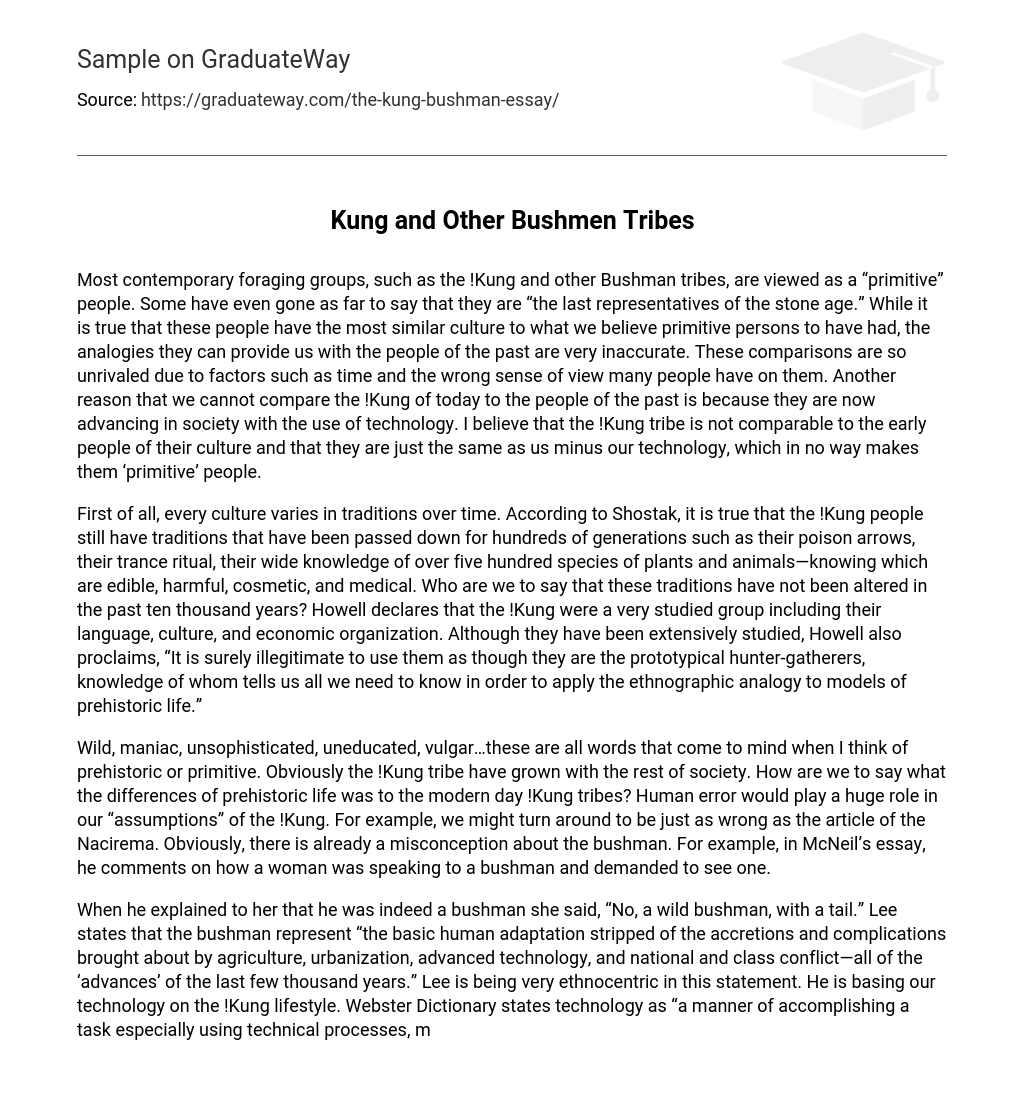Many contemporary foraging groups, including the !Kung and other Bushman tribes, are often seen as “primitive” and considered the last representatives of the Stone Age. However, while they do possess a culture similar to what we perceive as primitive, comparing them to people from the past is inaccurate due to various factors such as the passage of time and misconceptions. Additionally, the !Kung tribe has advanced in society with the adoption of technology. I believe that the !Kung tribe is not truly primitive but rather similar to us, excluding our technological advancements.
Every culture’s traditions change over time. The !Kung people have passed down traditions for generations, including poison arrows, trance rituals, and extensive knowledge of plants and animals. It is arguable whether these traditions have remained unchanged over the past ten thousand years. The !Kung have been extensively studied, including their language, culture, and economy. However, it is incorrect to assume that they represent the typical hunter-gatherer society and use them as a sole model for understanding prehistoric life.
When I think of prehistoric or primitive, words like wild, maniac, unsophisticated, uneducated, and vulgar come to mind. However, it is clear that the !Kung tribe has evolved alongside the rest of society. It is difficult to determine the differences between prehistoric life and the modern-day !Kung tribes. Our assumptions about the !Kung would likely be influenced by human error. We could potentially be just as incorrect as the Nacirema article. There is already a misperception about the bushman, as evidenced by McNeil’s essay where a woman demanded to see one while speaking to a bushman.
When he explained to her that he was indeed a bushman she said, “No, a wild bushman, with a tail.” According to Lee, the bushman represents the fundamental human adaptation devoid of the complexities and advancements brought about by agriculture, urbanization, advanced technology, and social conflicts associated with nation and class. Lee’s statement displays an ethnocentric perspective by comparing our technology to the lifestyle of the !Kung people. The definition of technology according to the Webster Dictionary is “a manner of accomplishing a task especially using technical processes, methods, or knowledge.” By this definition, the !Kung possess highly developed technology.
The bushman’s ability to complete tasks through precise processes, methods, and extensive knowledge showcases their remarkable culture. They can thrive without relying on our technology, establishing a distinct identity. However, this does not imply they are animal-like or uncivilized. On the contrary, their commendable techniques have sustained them for a considerable time. Additionally, they possess strong bonds of kinship that may surpass ours. Resolving conflicts without a leader and exhibiting collaborative teamwork highlights their self-sufficiency in this aspect.
Our methods, however, are exactly what the !Kung people are becoming involved in. According to Howell, most of the bushmen are settled on “settlement stations” with European farmers and cattlemen. They also speak multiple languages, use clothing, food, electronics, and inoculations that are bought from stores. They attend school and face taxes, jail, and even subordination. This phenomenon of “arrival” into what we perceive as the modern world is completely transforming the !Kung culture. Simultaneously, it serves as another justification for why they should not be labeled as primitive. To exacerbate matters, there are individuals who desire to rescue these so-called “primitive” individuals and confine them in zoo-like environments where they can be observed! In such a scenario, the bushmen would be treated as animals. The very fact that people are contemplating this process indicates that they already view them as animals.
This highlights ethnocentricity from those who support the establishment of these ‘prisons’. And what kind of culture would it represent? The New York Times article reveals that the !Kung tribe fools tourists by stating, “we change into beaded loin clothes. Skin quivers, bows and spears appear, and we lead people on a two hours track across the field.” The bushmen pretend to be someone they are not, satisfying the desires of the tourists. Consequently, this misleads tourists and contributes to the ignorance surrounding the !Kung tribe. This would have a devastating impact on their culture. Culture is associated with the changes a society undergoes over time. If these ‘prisons’ were established, the culture would be manipulated and therefore incomparable to earlier civilizations.
Although the !Kung people’s distinct and unique culture sets them apart from our own lives, it is crucial to acknowledge that they do not represent the culture of early inhabitants. They have developed their own society which, like ours, continues to evolve. The biased label of “primitive” often attached to them stems from comparing their culture to ours. Moreover, the !Kung possess their own efficient technology, essential for their survival throughout time. However, due to the passage of time and lack of knowledge about early peoples, it would be inaccurate to solely compare them based on their culture. It should be noted that the !Kung Bushmen are currently living in the present and should not be regarded as people of the past.





